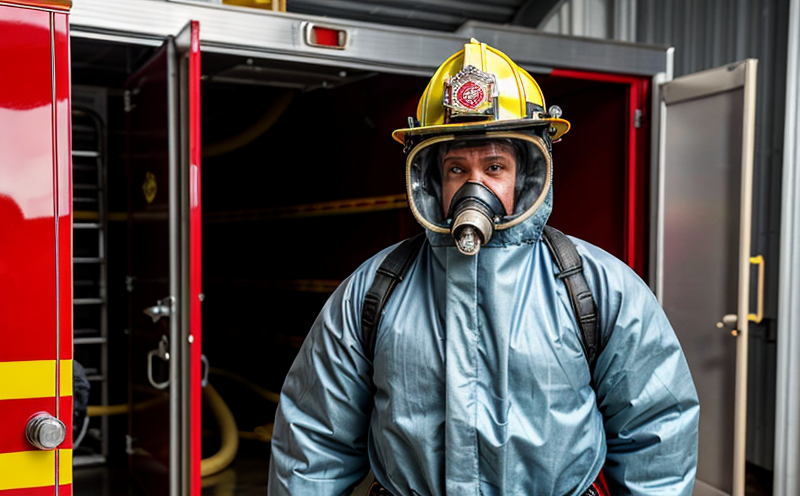Firefighter Clothing Weight and Mobility Assessment
The Firefighter Protective Clothing & Equipment Testing service ensures that protective gear meets rigorous standards of safety and performance. Among these tests is a critical assessment of firefighter clothing weight and mobility, which directly impacts the ability of firefighters to perform their duties effectively in hazardous environments.
Firefighters often work in extreme conditions where every ounce of clothing can affect their agility and efficiency. The weight of protective clothing must be optimized so that it provides necessary protection without unduly restricting movement or increasing heat stress during firefighting operations. This service evaluates the weight distribution, material composition, and design to ensure that the clothing remains lightweight while maintaining essential safety features.
Proper mobility is crucial for firefighters who need to navigate through tight spaces, climb ladders, and maneuver in hazardous situations. The mobility assessment focuses on how well the clothing allows a firefighter to move freely without compromising protection. This involves evaluating various aspects such as flexibility of materials, ease of movement in different body positions, and the overall fit of the garment.
Testing methodologies include standardized procedures based on international standards like ISO and ASTM, ensuring that all evaluations are conducted under consistent conditions. Specimen preparation typically involves measuring the weight of the clothing using precision scales and assessing mobility through controlled movements simulating real-world scenarios. The results provide detailed insights into how well the clothing meets both safety requirements and practical operational needs.
By conducting this assessment, we help ensure that firefighters have gear that enhances their performance rather than hinders it. This not only improves overall job satisfaction but also contributes to increased productivity and potentially saves lives by enabling quicker response times and more effective interventions.
Why It Matters
The importance of assessing the weight and mobility of firefighter clothing cannot be overstated. Lightweight yet robust, these garments play a vital role in ensuring that firefighters can perform their duties safely and efficiently. Excessive weight can lead to fatigue, reduced endurance, and increased risk of injury, all of which are detrimental during high-stress situations such as fires or rescue operations.
On the other hand, poor mobility can prevent firefighters from accessing critical areas quickly or executing necessary maneuvers effectively. Both factors significantly impact a firefighter's ability to perform their job optimally. By focusing on these aspects through rigorous testing, we ensure that the protective clothing not only meets safety standards but also enhances operational capabilities.
Moreover, this assessment helps in identifying potential improvements in design and material choices. Engineers and manufacturers can use the feedback from such tests to refine future iterations of firefighter clothing, making them lighter and more flexible without sacrificing essential protection features. This continuous improvement cycle is crucial for advancing fire safety standards and enhancing public service.
In essence, the weight and mobility assessment is a key component in ensuring that firefighters have the best possible tools at their disposal when faced with challenging situations. It underscores the importance of balancing comfort, functionality, and safety in developing effective firefighting gear.
Benefits
- Enhanced Performance: Lightweight clothing allows for better maneuverability, enabling firefighters to navigate complex environments more efficiently.
- Improved Comfort: Reduced weight leads to less fatigue and increased comfort during prolonged operations.
- Increased Safety: Properly balanced mobility ensures that firefighters can access dangerous areas quickly and perform critical tasks accurately.
- Elevated Operational Effectiveness: Better-fitting gear enhances overall performance, leading to more effective rescue missions and fire suppression efforts.
- Compliance with Standards: Rigorous testing against international standards ensures that all products meet strict safety requirements.
- Sustained Innovation: Continuous assessment drives ongoing improvements in design and material selection for future generations of protective clothing.
Industry Applications
The results from the weight and mobility assessment have broad applications across various sectors within fire safety. In urban firefighting, where narrow streets and tall buildings pose unique challenges, lightweight yet robust clothing is essential for swift deployment and effective operation.
In rural firefighting, where terrain can be rugged and unpredictable, flexibility in movement becomes crucial for navigating steep inclines and dense vegetation. Similarly, specialized units dealing with hazardous materials benefit from enhanced mobility that allows them to handle dangerous substances more safely and effectively.
For training purposes, accurate assessments provide valuable data on how different types of clothing perform under simulated conditions, helping trainees prepare better for real-world scenarios. This information is also beneficial for customizing protective gear according to specific operational needs within the fire service.
In summary, the weight and mobility assessment plays a pivotal role in optimizing firefighter protective equipment across diverse environments and operations, ultimately contributing to safer and more efficient firefighting efforts.





